I will be travelling again for about a month. Will likely to have some new photos to post after the trip. For the time being, there will be less frequent posting in the next 20+ days.
March 26, 2010
Frontal view of Dafo at Leshan, Sichuan, China
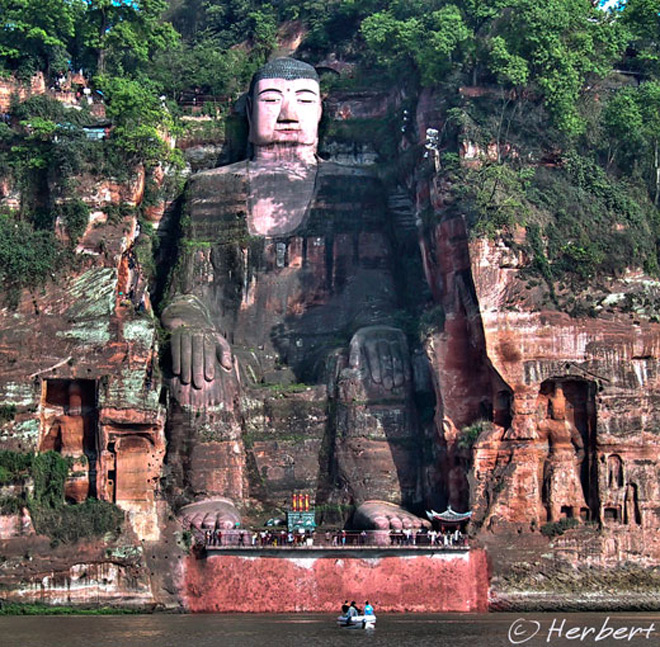
Location: Leshan Dafo, Sichuan, China (29° 32′ 50″ N, 103° 46′ 9″ E)
Date: 17 April 2003; 11.25am
Camera: Canon G1
Dafo at Leshan (乐山大佛), not far from Chengdu is the world's tallest stone-carved seated Buddha figure. It is none of the more popular tourist destinations in China, partly due to its easy access and proximity to Chengdu. The giant carved Buddha had suffered from the effects of pollution from the industries established around the region and is consistently being maintained to ensure that the damage is controlled. This is a view of the Buddha that is seldom seen by most visitors- they normally hang around the temple and cafe near the top, side and bottom of the statue. However one can catch a boat to Dafuba, the sand spit/island on Minjiang River, right in front of the statue.
March 24, 2010
View from a window- the Basilique Sacré-Coeur, Paris
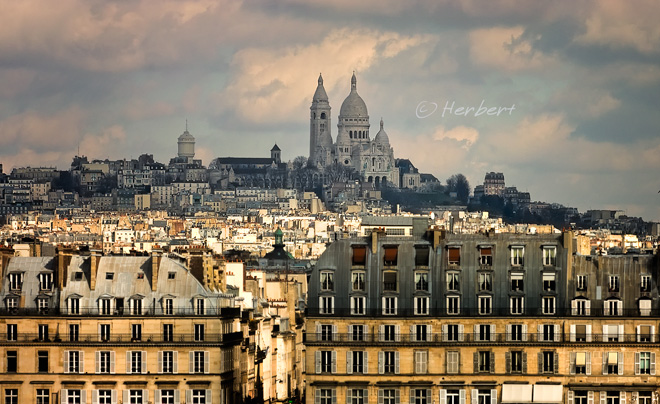
Location: Basilique Sacré-Coeur from Musee d’Orsay, Paris, France (48° 51′ 36″ N, 2° 19′ 37.2″ E)
Date: 28 February 2006; 12.05pm
Camera: Canon 300D with kit kens
The Basilique Sacré-Coeur (Basilica of the Sacred Heart) is a Roman Catholic church and familiar landmark in Paris. Apart from its beauty and significance in Paris’s history, its location at the summit of the butte Montmartre, the highest point in Paris makes it a very visible landmark. As such it can be seen from many locations. This photo was taken from the 4th floor window of the Musee d’Orsay. The basilica appears to just tower over all the other buildings. However this may change with the Paris council approval of high-rise construction in the city.
March 20, 2010
India has one of the biggest rail networks in the world
Date: 22 Dec 2008; 7.42am
Camera: Canon 400D with Sigma 17-70/f2.8-4.5
March 18, 2010
The enigmatic Potala Palace, Lhasa
Locations: Potala Palace, Lhasa, Tibet, China (29° 39′ 28″ N, 91° 7′ 1″ E)
Date: 18 May 2005; 5.50pm
Camera: Canon IXUS IZoom
Potala Palace is one of the most enigmatic and recognisable building in the world. It was the principal residence of the Dalai Lama until he fled Tibet after the Tibetan uprising. Today the Palace is a museum and is one of the most popular tourist destinations in Lhasa- it has limited the number of entrants a day and its entrance tickets are sold out every day. The hordes of tourists are apparently causing concern of stress to its structure. The palace sits atop the Potala Peak. Its surroundings used to be rather rural in nature- I remembered how rural the surroundings was when I saw the "Rainbow over Potala Palace" photo by Galen Rowell many years ago. It is now totally different. The Chinese government had spent a lot of money transforming the surrounds of the Palace into just like any other Chinese cities; including building the immense Potala Palace Square or People's Park in front of the Palace. Well, I guess that's developments in the eyes of the Chinese government.
March 16, 2010
The majestic Taj Mahal, Agra, India

Location: Taj Mahal, Agra, Uttar Pradesh, India (27° 10′ 48″ N, 78° 1′ 12″ E)
Date: 29 August 1998; 9.20am
Camera: (analogue) Canon 500N with negatives and scanned
This is the frontal view of that most famous monument of love, Taj Mahal, that most people often sees. This is also the so-called symmetrical view where one sees all the elements of the Taj’s architecture in perfect symmetry. However personally I like the view from across the Yamuna River better. However a little bit of effort is needed to see that.
March 13, 2010
Sand dunes of Mingsha, Dunhuang, China, at dusk.

Locations: Mingsha, Gansu, China (40°5'18"N 94°40'33"E )
Date: 5 October 2008; 9.20pm
Camera: Canon 400D with Sigma 17-70/f2.8-4.5
Same place, more than 4 years later. This photo was taken on my 3rd visit to Mingsha, the first time in 1999 and the second time in 2004 where I have written a post in this blog before. The place is more developed and touristy now. However it is still a wonderful place to visit especially if one ventures a little further from the dunes near the entrance. There is peace and quiet with nothing else but the sand dunes (and perhaps the heat depending on when and what time of the day one visits).
March 11, 2010
“the Creation of Adam’ by Michelangelo in the Sistine Chapel, Vatican
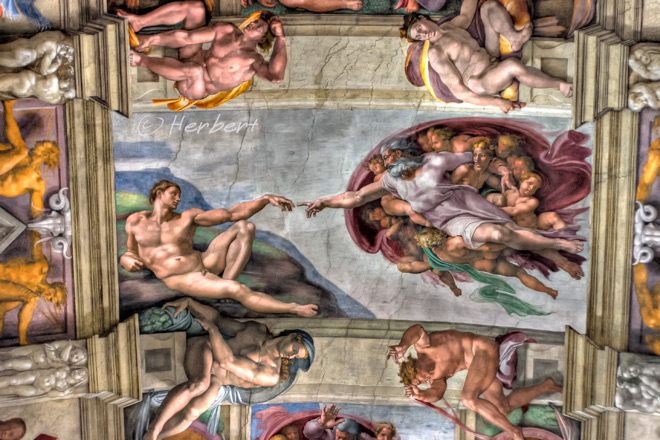
Location: Sistine Chapel, Vatican, Italy (41° 54′ 8″ N, 12° 27′ 23″ E)
Date: 22 March 2006; 11.15am
Camera: Canon IXUS iZoom
The Sistine Chapel is the most well-known chapel in the Apostolic Palace which is the Pope’s official residence in the Vatican. The Sistine Chapel is well-known for a few reasons. It was made famous and widely-known from the novel “Angels & Demons” as the Papal conclave- the venue for the election of successive Popes. However, it is probably better known for its interior decoration especially the immense frescoes painted by some of the best-known Renaissance artists including Michelangelo, Raphael and Bernini. Michelangelo probably painted his best in the Chapel; by expert account, his “The Last Judgement” was his best painting. But its popularity is overshadowed by perhaps the most well-known artworks of all time, Michelangelo’s “The Creation of Adam”. “The Creation of Adam” is so popular in modern pop culture that it has continuously been parodied in the last few decades. By the way, photography is strictly prohibited in the Sistine Chapel but this is often ignored. I was going to follow this restriction when I visited the Chapel and kept my DSLR in my bag to demonstrate my respect. However, the majority of the tourists in the few hundreds who were in the Chapel on that day showed no inhibition whatsoever- clicking away on their cameras, with some even using flashes (my observation is that most digicam users do not know how to operate their cameras and so, do not know how to turn off their flash). I could not resist the temptation and sneak out my digicam and took a photo.
March 7, 2010
Sun set rays behind Namgyal Tsemo Gompa, Leh, Ladakh, India

Location: Namgyal Tsemo Gompa, Leh, Ladakh, India (34° 10′ 3″ N, 77° 35′ 24″ E)
Date: 18 August 2009 5.50 pm
Camera: Canon 400D with Sigma 17-70/f2.8-4.5
Leh is one of those places that used to evoke a certain sense of mystique. One of the reasons is its isolation due to its inaccessibility, being only reachable by roads for few months of the year. Even during those months, the road conditions between Leh and Menali can still be quite an adventure. Well, this is no more as there are now many daily flights between Leh and Delhi operated by a few airlines and some of them are reasonably inexpensive if booked in advance. However the best way to get to Leh is still by road as the journey itself is quite an adventure with beautiful sceneries to be had along the way. A word of caution- as the road passes over a few 4,000+ meters passes, the risk of AMS is high. At Leh, one can be awarded with a fabulous panorama of the town set amongst the snow-covered peaks of the Ladakh Range. When in Leh, another must-go destination to enjoy the panorama from a different perspective is from the Shanty Stupak. From here, you will have the view of this photo, looking across towards the town with its enigmatic Leh Palace and the Nagoya Stem Gump pictured here (best visited for sunset).
March 4, 2010
The western end of the Great Wall in the Gobi Desert- Jiayuguan
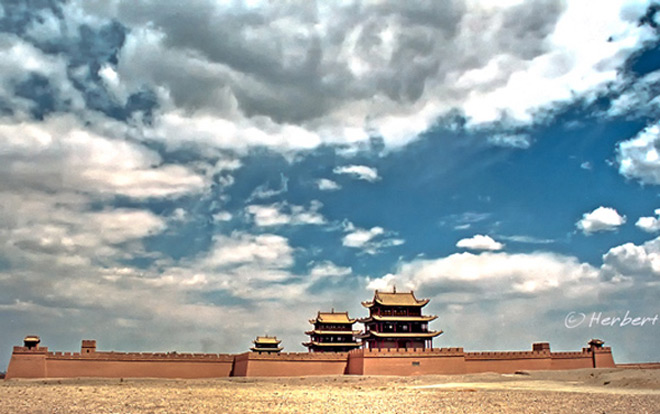
Location: Jiayuguan, Gansu, China (39° 49′ 0″ N, 98° 18′ 0″ E)
Date: 16 May 1999; 2.30pm
Camera: (analogue) Canon 500N with negatives and scanned
Many foreigners to China only know of the Great Wall in the few touristy locations of Beijing. These are really touristy now with KFC and so on, and the sections are all refurbished and restored. By the end of this year, there is even a metro going all the way to Badaling. There are many other sections of the Great Wall that are still worth visiting for their locations and atmosphere. One of the most enigmatic sections is that located at the Jiayu Pass at Jiayuguan in Gansu. Located in the Gobi Desert at the westernmost end of the Great Wall, it is the most intact and largest fortress/section of the Great Wall. It sits between two hills (hence a pass) and is at a strategic location to guard the western frontier of the Middle Kingdom. It used to be rather involved to get to this destination (when I went in 1999); however it is much more accessible now as it is now a major tourist destination. When I visited the fortress more than 10 years ago, it was very much in its original state, majestically standing alone in the desert and full of mystique. I am afraid it is not likely to be the same now- I imagined the fortress is fully restored with fresh paint, congested with busloads of tourists and with many stalls selling souvenirs, food, drinks and the like- just like any other tourist spots “discovered” in China.
March 1, 2010
Old traditional Malay house on stilts, Johor, Malaysia
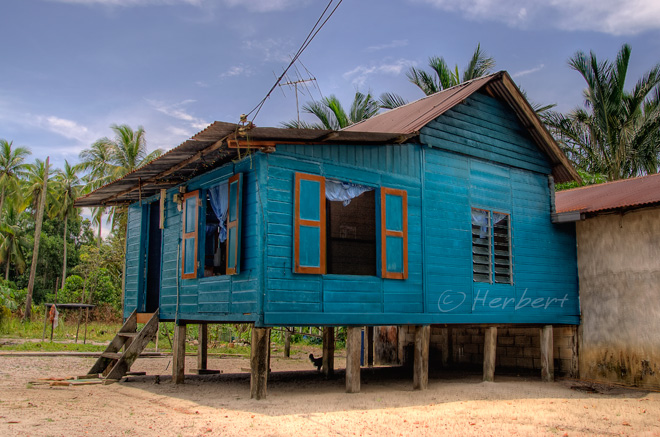
Location: Kampung Sebong, Johor, Malaysia (1°21'24.92"N 104° 7'47.36"E)
Date: 18 April 2008 10.40am
Camera: Canon 400D with Sigma 17-70/f2.8-4.5
There are still many rural areas in Malaysia, replete with old Malay traditions and architecture. An example is this traditional Malay house that sits on stilts. This is still a common sight in many “kampungs” or villages, easily noticed when one drives around the country-side . The houses sit on stilts to allow better ventilation as well as to avoid floods and having crawlies (read snakes) into the houses. Believe it or not, these houses are still abundant in downtown central Kuala Lumpur, in the area known as "Kampung Baru.” This is a huge swath of land in central KL that is still undeveloped as it is “Malay Reserve Land” with many restrictions on titles including prohibition on its ownership by non-Malays (or non-Bumiputras). This may change soon as the government is mulling changes in the law to enable this expensive landmass to be developed easier.



















